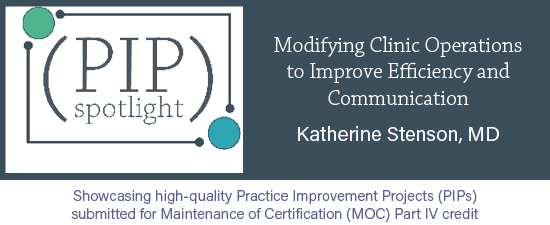CC
PIP Spotlight: Modifying Clinic Operations to Improve Efficiency and Communication

ABPMR diplomate Katherine Stenson, MD, submitted this Practice Improvement Project (PIP) after making significant modifications to her spinal cord injury clinic’s care-delivery model. Noting inefficiencies in the structure of the outpatient clinic, Dr. Stenson led the project with the ultimate goal of improving efficiency and communication for patients.
Thank you for sharing your PIP, Dr. Stenson!
The PIP Spotlight is a periodic feature on News Center to highlight exemplary Practice Improvement Projects submitted by your fellow diplomates (or residents) for maintenance of certification (MOC) Part IV credit. Diplomates can use the PIP Spotlight as a tool to plan their own PIPs or as a way to connect with other diplomates doing similar work.

What is the problem you are trying to solve?
The current spinal cord injury (SCI) clinic care-delivery model does not provide optimal clinic access, continuity of care, nor an adequate level of patient communication. SCI staff are dissatisfied with clinic staff communications that are slow to respond to patient needs.
What data (objective measurements) do you have that supports this as a problem?
A project was instituted and the current state and target state were identified, along with a gap analysis. The gap analysis found that the two most highly weighted issues were “multiple providers/no one provider” with a score of 28 and “staff not available” with a score of 27. In order to determine if access to the clinic increases with a more efficient structure and communication, the number of patients being seen in outpatient clinic will be tracked.
Preliminary staff interviews were conducted. Of the clinic staff (nurses, physicians, and nurse practitioners) 100% were dissatisfied with the current structure of the outpatient clinic. Given the lack of a consistent provider in clinic (clinic days were rotated among each physician) nurses cited not knowing which provider to call on any given day about an outpatient issue, which caused the following:
- inefficiency (nurse would often have to call multiple providers to find the correct covering MD)
- annoyance to the nurse and the physician (who may not be the correct provider to contact about a specific patient's issue)
- potential safety issues for the patient if this inability to communicate quickly with the responsible provider delays care of a critical medical problem
Not having a provider dedicated to the clinic also hampered the SCI unit's ability to absorb walk-in patients or to make same-day appointments for patients who have a need arise, which is a potential patient safety issue.
Similarly, with a rotating-provider structure in the clinic, there was limited continuity of care for patients with issues that persist over multiple days. If one provider fielded a phone call one day and made recommendations and the patient came into clinic the next day, the provider covering that day would not be aware of what had already been discussed or decided, thus potentially hampering clinical care and potentially causing additional work for staff and providers as well as patient safety issues from poor handoff of information.
As such, it was felt that the structure, efficiency, and communication of the clinic could be improved, which would also improve the day-to-day operations and communication and make the clinic more efficient and better able to address the needs of more patients.
What is your opportunity statement? State the goal you hope to achieve.
Based on review and measurement of current performance, the goal was to increase SCI clinic access by 20% within three months.
What is the underlying cause of the performance/quality problem?
The cause of clinic inefficiency and a limitation to clinic access were determined by staff interviews initially. We had an idea from the outset of what was causing the issue. However, once the project was started, we mapped the current state, target state and did a gap analysis.
The gap analysis confirmed what was uncovered in the staff interviews with the following determined as the biggest causes of clinic inefficiency:
- “multiple providers/No one provider” (score 28)
- “staff not available” (score 27)
Other high-ranking issues that emerged from the gap analysis that also detracted from clinic efficiency and access were as follows:
- no check-out process (score 17)
- supplies not available in the clinic (score 16)
- walk-ins allowed at all hours (score 13)
- staff communications (score 10)

What change(s) did you implement?
- Designated one SCI provider for assignment as the primary SCI clinic provider. The SCI nurse practitioner was designated as the primary care provider in the clinic to manage a daily clinic appointment grid, walk-in patients, and same-day/open clinic appointments.
- Established SCI physician panels for established patients. Each established patient was placed on a physician panel and posted on SharePoint. The panels provided concrete reference for the SCI nurse practitioner to ensure continuity of care for patient referrals in in those instances in which a physician would be called on to problem-solve about a specific patient with the nurse practitioner or make decisions that are potentially out-of-scope for the nurse practitioner.
- A patient check-out process was established.
- SCI clinic supplies inventory and supply storage was completed and medical supply inventory par levels were established.
- SCI patient correspondence was sent regarding the change in staffing structure of the SCI clinic.
- Daily clinic team huddles were established for optimal communication, and weekly appointment pre-planning meetings for the clinic staff were established.
- Pre-clinic appointment reminder calls were instituted to remind the patient of when to present to clinic but also to determine if there is any specific information from the patient that would be relevant for that clinic day.

Did you achieve your goal or target from your opportunity statement? What data do you have to support your conclusion?
Ultimately our goal was to restructure the clinic in order to increase clinic efficiency and access in order to serve more patients. We did achieve our goal, although not by our initial target date. By clinic utilization data, there was a 12% increase in clinic visits in Q3 of FY2016 vs. Q3 of FY2015 and a 21% increase in clinic visits in Q4 of FY2016 vs. Q4 of FY2015.
On follow-up interviews with the nurses, physicians, and nurse practitioners initially interviewed about the state of the outpatient clinic, 100% feel that the changes implemented represent an improvement. The communication has improved by virtue of the clinic now being a cohesive team and, more objectively, by going from no daily huddles or weekly meetings to ongoing, structured communication in these formats.

Will you continue with the changes you have implemented?
Yes, we have achieved our goal and continue to see measurable increases in the access and utilization of the SCI outpatient clinic. We have since completed a formal process improvement project that allowed us to revamp our SCI annual evaluations which we feel is building on our success in this first project. The level of internal satisfaction with the results of this project are shared by the SCI team and the St. Louis VA executive team and we are hearing feedback from our patients on a weekly basis that they are experiencing a higher level of satisfaction.

